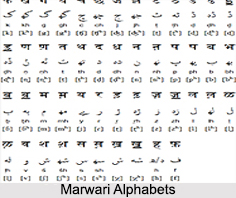 Marwari language is widely spoken in Rajasthan as well as its adjacent areas, namely, Gujarat, Madhya Pradesh, Punjab, Delhi, Haryana and Uttar Pradesh. Marwari is also spoken extensively in and around Jodhpur region. Amongst the Indo- Aryan language family, Marwari language is the largest one belonging to its Rajasthani language zone. All the other languages of the same Rajasthani zone are Shekhawati, Hadoti, Dundhari, Mewar, Brij, Bagri, Wagri, Mewati; they maintain an association with Marwari to a great extent.
Marwari language is widely spoken in Rajasthan as well as its adjacent areas, namely, Gujarat, Madhya Pradesh, Punjab, Delhi, Haryana and Uttar Pradesh. Marwari is also spoken extensively in and around Jodhpur region. Amongst the Indo- Aryan language family, Marwari language is the largest one belonging to its Rajasthani language zone. All the other languages of the same Rajasthani zone are Shekhawati, Hadoti, Dundhari, Mewar, Brij, Bagri, Wagri, Mewati; they maintain an association with Marwari to a great extent.
In the year 1994, a special survey, as conducted by IMA, registered that there are 12,104,000 Marwari speakers. Marwari language is written in the Devanagari script. Still now, no official status has been bestowed upon it and the Government is taking actions to implement it as soon as possible. To popularize the language, a recent Hindi movie, "Paheli" that has made use of Marwari language, gained national importance. Near about twenty-three dialects are found embellishing the Marwari language.
History of Marwari Language
According to the scholars, Marwari and Gujarati were evolved from "Gujjar Bhakha" or "Maru-Gurjar", which was the language of the Gurjars. Grammar of Gurjar named "Apabhramsa" was written by Jain monk and popular Gujarati scholar Hemachandra Suri.
Morphology of Marwari
Sentence construction of Marwari is quite similar to that of Hindi; first comes subject, then object and then verb. Most of the pronouns and interrogatives are distinct than Hindi.
Vocabulary of Marwari
Marwari vocabulary is similar to that of other Western Indo-Aryan languages, especially with Rajasthani and Gujarati. Moreover, the language uses many words, which are found in Sanskrit rather than in Hindi.
Writing Method of Marwari
Marwari is generally written in Devanagiri script, but traditionally it was written in Mahajani script. Historical Marwari orthography for Devanagari uses other characters rather than standard Devanagiri letters.
This article is a stub. You can enrich by adding more information to it. Send your Write Up to content@indianetzone.com.



















